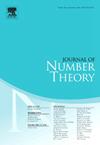t模的Weil-Barsotti公式
IF 0.6
3区 数学
Q3 MATHEMATICS
引用次数: 0
摘要
在M. a . Papanikolas和N. Ramachandran(2003)[26]的工作中,证明了关于Extτ1(E,C)的函数场情况的Weil-Barsotti公式,其中E是Drinfeld模,C是Carlitz模。我们将这个公式推广到E是一个严格纯的t模Φ和零幂零矩阵NΦ的情况。对于这样一个t模Φ,我们∨显式地计算它的对偶t模Φ以及它的双对偶Φ。这种计算是通过结合F. Głoch, D.E. Kędzierski, P. krasoski, [arXiv:2408.08207][13]和D.E. Kędzierski和P. krasoski(2024)[20]的工作方法以一种微妙的方式完成的。如果幂零矩阵NΦ不为零,我们也给出了Weil-Barsotti公式的一个反例。本文章由计算机程序翻译,如有差异,请以英文原文为准。
Weil-Barsotti formula for T-modules
In the work of M. A. Papanikolas and N. Ramachandran (2003) [26] the Weil-Barsotti formula for the function field case concerning where E is a Drinfeld module and C is the Carlitz module was proved. We generalize this formula to the case where E is a strictly pure t-module Φ with the zero nilpotent matrix . For such a t-module Φ we explicitly compute its dual t-module as well as its double dual . This computation is done in a subtle way by combination of the t-reduction algorithm developed by F. Głoch, D.E. Kędzierski, P. Krasoń, [arXiv:2408.08207] [13] and the methods of the work of D.E. Kędzierski and P. Krasoń (2024) [20]. We also give a counterexample to the Weil-Barsotti formula if the nilpotent matrix is non-zero.
求助全文
通过发布文献求助,成功后即可免费获取论文全文。
去求助
来源期刊

Journal of Number Theory
数学-数学
CiteScore
1.30
自引率
14.30%
发文量
122
审稿时长
16 weeks
期刊介绍:
The Journal of Number Theory (JNT) features selected research articles that represent the broad spectrum of interest in contemporary number theory and allied areas. A valuable resource for mathematicians, the journal provides an international forum for the publication of original research in this field.
The Journal of Number Theory is encouraging submissions of quality, long articles where most or all of the technical details are included. The journal now considers and welcomes also papers in Computational Number Theory.
Starting in May 2019, JNT will have a new format with 3 sections:
JNT Prime targets (possibly very long with complete proofs) high impact papers. Articles published in this section will be granted 1 year promotional open access.
JNT General Section is for shorter papers. We particularly encourage submission from junior researchers. Every attempt will be made to expedite the review process for such submissions.
Computational JNT . This section aims to provide a forum to disseminate contributions which make significant use of computer calculations to derive novel number theoretic results. There will be an online repository where supplementary codes and data can be stored.
 求助内容:
求助内容: 应助结果提醒方式:
应助结果提醒方式:


